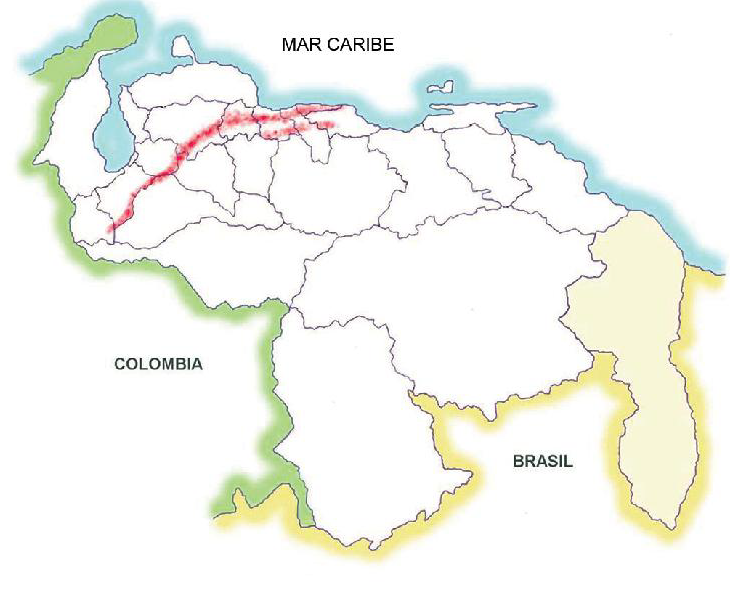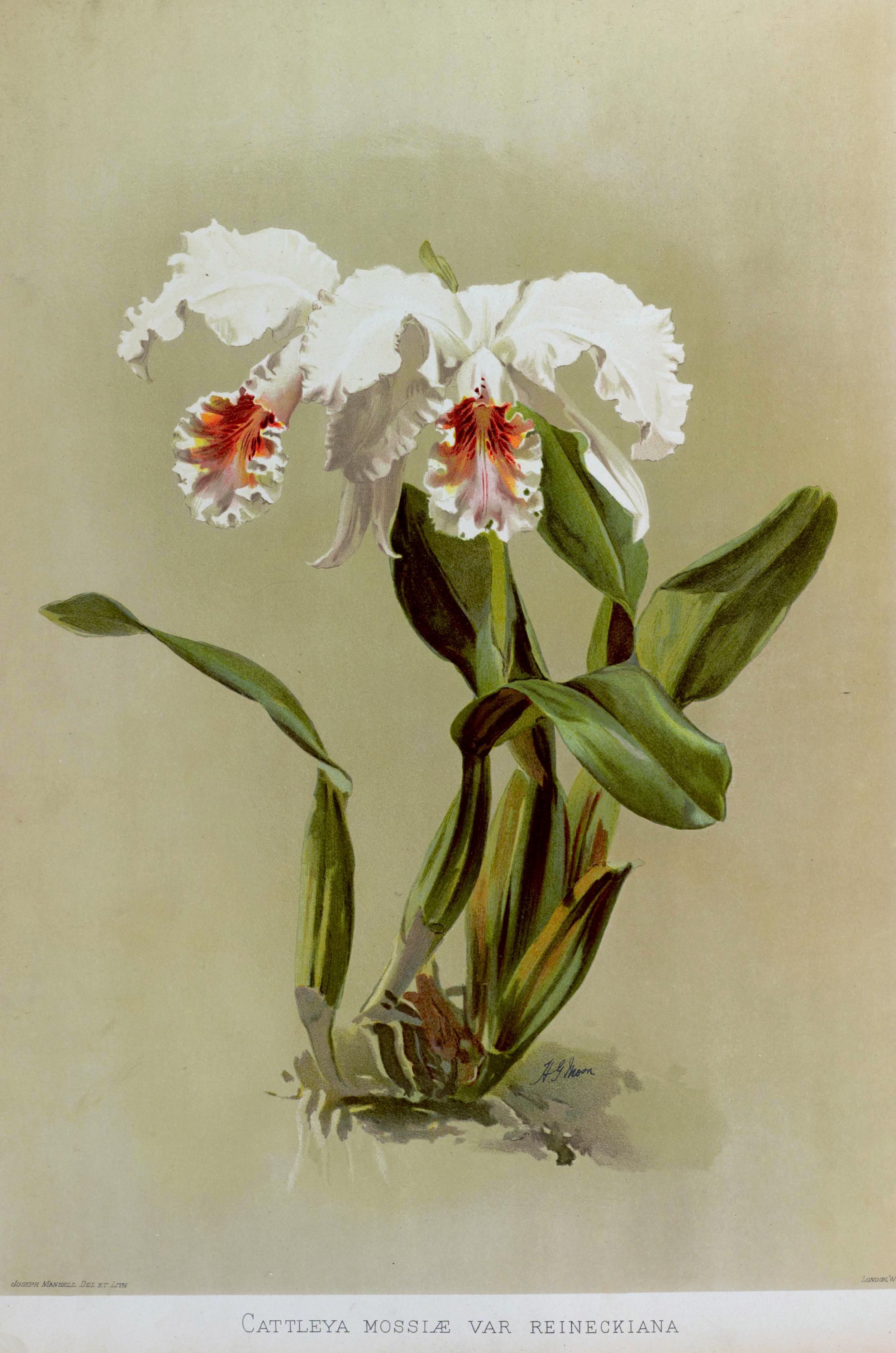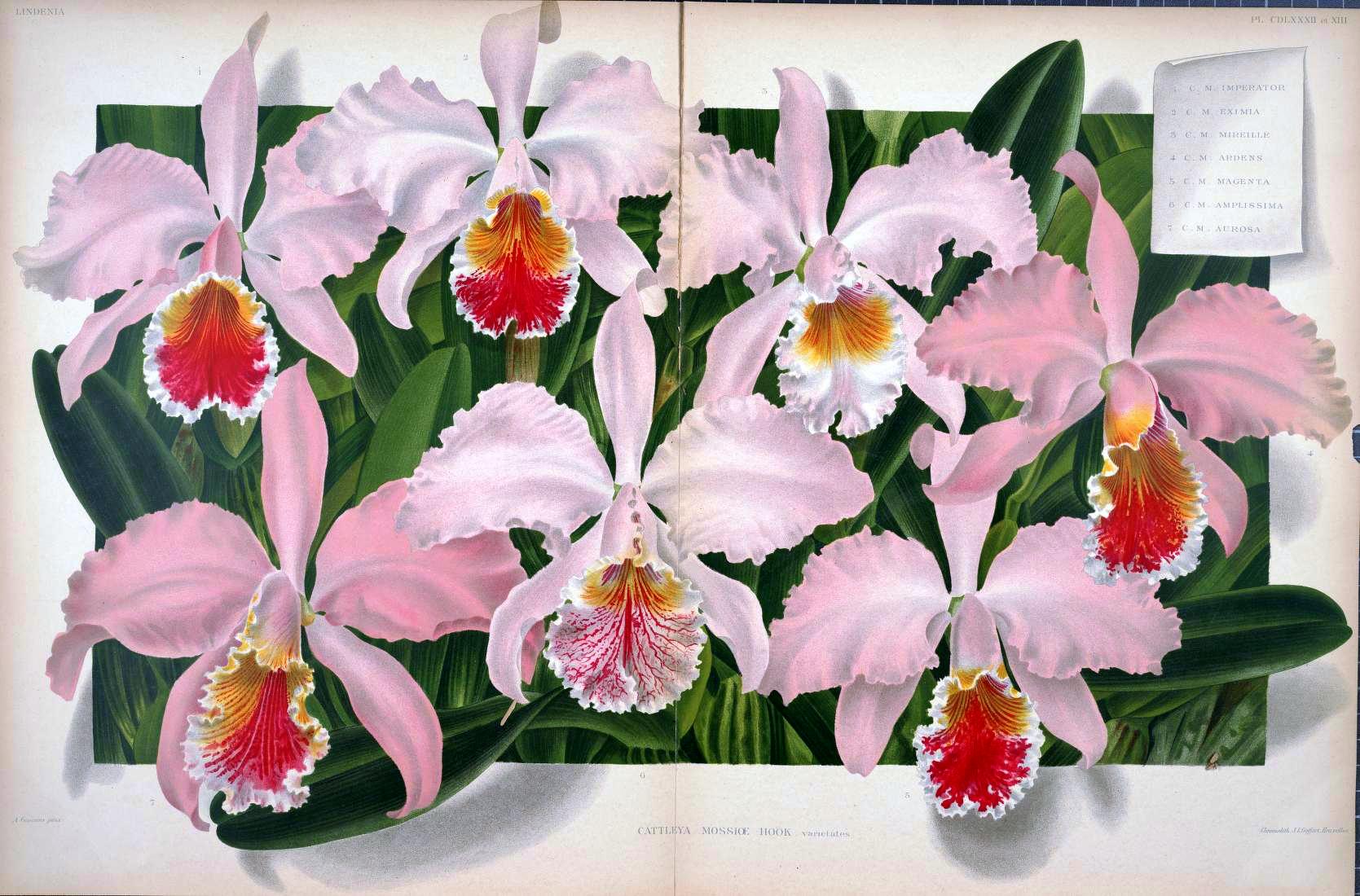Curtis’s Botanical Magazine 65: t. 3669 (1838)
It was the first Venezuelan Cattleya to be described. In 1836 the first plants were sent to Europe from the port of La Guaira, apparently by a gentleman named Ward, who was an English gentleman based in Caracas. He forwarded them to Miss Isabel Alderson, who in turn gave them to Mr. Thomas Moss, owner of large greenhouses in Otterpool, in the north of England. Mr. Moss’s wife made a magnificent portrait of the first plant to flower, so Sir William J. Hooker decided to dedicate this new species to her in 1838. Of her he wrote: “I wish the illustration would do justice to this one, the most wonderful among all orchids. The flowers of this magnificent family are the largest known to the present; these too are conspicuous, and no brush or art can equal them…the diameter of this splendid flower is seven and a half inches from the tip of the dorsal sepal to the apex of the lip, and between the tips of the two petals eight inches and half; each petal is over four inches long and two and a half inches wide” (Aulisi & Foldats, 1989).
Cattleya mossiae is endemic to Venezuela and has been the national flower since May 24, 1951 (before it was). It lives between 800 and 1500 meters above sea level. It is present in a very wide area of the center-north and western regions of the country, in the Coastal Mountain Range, from Cape Codera in the state of Miranda, to Puerto Cabello in the state of Carabobo, passing through the Metropolitan District of Caracas and the Vargas and Aragua states. It then continues west through the mountains of the Yaracuy, Lara and Portuguesa states until it enters the Andes mountain range in the states of Trujillo, Mérida and Táchira. Between the parallels 8° and 11° north latitude and the meridians 65° and 71° west longitude.

This huge distribution area would suggest large and healthy populations, but nothing could be further from the truth: their habitats have been systematically looted, to the point that entire areas have been left without this beautiful species, especially those closest to large cities. as is the case of El Avila hill, a mountain that adorns the city of Caracas where, until the 1950s, it was common to see them in large colonies on trunks and branches of the Bucares (Erythrina poeppigiana), Ceibas (Ceiba sp.) and other species. Currently the largest populations are found in the Portuguesa and Mérida states.
Cattleya mossiae presents unifoliolate pseudobulbs, narrow-ellipsoid, laterally compressed, attenuated towards the base, up to 25 cm long, with two, rarely three, internodes. The leaves are leathery, narrow-obovate to elliptic. Simple spathe, which dries months before flowering (this characteristic is very typical of Cattleya mossiae). However, plants sometimes develop a new pseudobulb close to flowering time, which may flower as a green spathe.
Its flowering season extends from March to early June, but the alba and semialba varieties tend to flower a little earlier than the purple ones. It presents bunches of up to 7 flowers, upright, elegant and well arranged on the foliage. The flowers, which reach up to 23 cm in diameter, tend to be somewhat gangly with the petals and dorsal sepal drooping backwards. The type variety is light pinkish-purple, with a very ruffled and wonderfully colored lip. The throat shows us a golden yellow to orange base color crossed by reddish purple streaks. In the frontal lobe it presents generally white borders, the purple spot mixes with the yellow color in an indescribable filigree of dots and stripes. Sometimes this spot appears solid, only mixed with the yellow at the throat entrance.
In addition to the type variety, there are other less common varieties, such as alba, semialba, coerulea and concolor. In some clones of the concolor variety the yellow of the throat descends very low on the disk. This variety is known as “Aurea”. In some semialba, the color of the labellum spot is a very delicate pink. We call these plants “Alexandras”.
It has been widely reproduced in the laboratory, especially the semialba variety, which is preferred by growers. Almost all the good clones we have today come from two wild plants that were very famous between 1970 and 1990: Blanca and Aurora. Two other semi-alba plants, with spots on the apexes of petals and sepals, have produced the marvelous crooked forms that we can admire today: María Gallego and Featherston.
The type variety has been relegated to the background, the few crosses that have been made have not represented a significant improvement in the quality of the offspring. Currently the best type plants are being crossed with very good half-albs to try to inject their best shape and substance into the purple color. In the caerulea variety, it is worth highlighting the promising result of the self-fertilization of the plant called “Andreina”, carried out by Mr. Héctor Alvarez, an excellent grower from the state of Miranda. Several daughters have shown outstanding qualities, well above the average for the species.
Among the clones worth mentioning we have:
- type: Natalia, Potrerito
- alba: Barroeta, Edmea
- semialba: Aurora, Blanca, Julieta Bosque, Doña Pepa, Doña Carmela, Diana, Featherston, Hilton, Payas
- caerulea: Maria T, Andreina
Notable Varieties:
Between 1865 and 1913, the RHS gave its coveted awards, including 37 AMs and 16 FCCs, to 53 C. mossiae clones. The number of named clones of C. mossiae is almost endless and there were already more than 150 recorded in the literature by 1900.There are more alba forms of C. mossiae than any other Cattleya species, probably because of its abundance.
- C. mossiae f. alba ‘Lawrenciae’ AM/RHS (1899) – nice alba form
- C. mossiae f. alba ‘Mrs. F. W. Ashton’ AM/RHS (1901) – alba form with rabbit ear petals
- C. mossiae f. alba ‘Queen Mary’ AM/RHS (1911) – alba form with upright petals
- C. mossiae f. alba ‘Tracy’ FCC/RHS (1905) – alba form with very pleasing composition
- C. mossiae f. wageneri ‘Hassall’ AM/RHS (1900) – alba form
- C. mossiae f. wageneri ‘Sanderae’ AM/RHS (1909) – alba form with upright petals
- C. mossiae f. reineckiana ‘Young’s Variety’ – standard semialba form for over 70 years, shown on book page 66
- C. mossiae f. reineckiana ‘The Baron’ FCC/RHS (1906) – semialba form
- C. mossiae f. reineckiana ‘Excelsa’ FCC/RHS (1905) – semialba form
- C. mossiae f. semialba ‘Alexandrae’ FCC/RHS (1903) – pale semialba form
- C. mossiae f. semialba ‘Arnoldii Westfield’ AM/RHS (1902) – semialba form with almost blue lip
- C. mossiae f. semialba ‘Goossensiana’ AM/RHS (1899) – nice semialba form with slight dark tinge on petal tip
- C. mossiae f. semialba ‘Goossensiana’ FCC/RHS (1908) – nice semialba form with slight dark tinge on petal tip
- C. mossiae f. semialba ‘Madonna’ AM/RHS (1898) – very pale semialba with upright petals
- C. mossiae f. semialba ‘Magali Sander’ AM/RHS (1910) – very nice semialba
- C. mossiae f. semialba ‘Our Queen’ AM/RHS (1900) – semialba form
- C. mossiae ‘Mrs. J. T. Butterworth’ FCC/AOS (1941) – was sold for $10k USD that time. It has 9.5 inch wide flower and it was the only FCC from AOS until the end of 20th century, shown on book page 67
- C. mossiae ‘Ed Patterson’ AM/AOS – classic rose-lavender wild plant, shown on book page 65
- C. mossiae ‘R.E. Patterson’ – dark lip color extend to the edge of the lip so there is no splash pattern and it has unusual upright petals albeit the normal-size flowers, shown on book page 68
- C. mossiae ‘Orchidhaven’ – a tetraploid form
- C. mossiae ‘Julie’ – a tetraploid form
- C. mossiae ‘Anthony Alfieri’ AM/AOS – best shaped ever exhibited, it was a slectiong from a selfing of John Mossman’s C. mossiae ‘Julie’, shown on book page 69
- C. mossiae ‘A. Dimmock’ AM/RHS (1909) – typo form with white lining on the lip
- C. mossiae ‘Aurora’ AM/RHS (1902) – typo form, pale lip
- C. mossiae ‘Beauty of Bush Hill’ FCC/RHS (1899) – typo form with fine lines on petals and dorsal sepal
- C. mossiae ‘Countess Grey’ FCC/RHS (1909) – typo form very impressive dark lip
- C. mossiae ‘Dreadnought’ AM/RHS (1913) – typo with fuschia pink perianth and unusual lip pattern
- C. mossiae ‘Dulcis’ AM/RHS (1901) – typo with balanced shape and nice dark lip
- C. mossiae ‘G.M. Hale’ AM/RHS (1911) – dark lavender form, balanced shape and dark lip with contrasting yellow upper part of the lip
- C. mossiae ‘Gatton Park’ AM/RHS (1909) – typo form with nice striation on lip
- C. mossiae ‘Gloriosa’ AM/RHS (1899) – typo form with darker petals and nice dark lip
- C. mossiae ‘Jeremiah Colman’ AM/RHS (1906) – nice typo with nice white lining on lip edge, upright petals
- C. mossiae ‘Le President’ AM/RHS (1908) – typo form with balanced composition and nice petals
- C. mossiae ‘Madame Jules Hye’ AM/RHS (1912) – typo form with wide-spread petals and dark lip
- C. mossiae ‘Memoria A. H. Smee’ AM/RHS (1902) -nice dark lavender form, nice firmly held petals
- C. mossiae ‘Memoria Richard Curnow’ AM/RHS (1897) – typo with droopy petals
- C. mossiae ‘Mrs. A. Goodson’ AM/RHS (1906) – bizzare pattern, consistent for 3 years
- C. mossiae ‘Mrs. C. H. Feiling’ AM/RHS (1899) – typo form with dark stripe on petal tips
- C. mossiae ‘Olympia’ AM/RHS (1913) – nice fuschia color with upright petals and nice composition
- C. mossiae ‘Princess of Wales’ AM/RHS (1907) – typo form with very big petals
- C. mossiae ‘Queen Empress’ AM/RHS (1897) – typo form with droppy petals
- C. mossiae ‘Rouselliana’ AM/RHS (1900) – typo with droopy petals
- C. mossiae ‘Aureola’ AM/RHS (1911) – quasiconcolor form with gorgeous golden lip
- C. mossiae ‘McMorlandii’ FCC/RHS (1879) – very pretty concolor form
- C. mossiae ‘Victoria’ AM/RHS (1899) – concolor with droopy petals
Notable Primaries:
- C. Canhamiana (C. mossiae f. semialba x C. purpurata)

